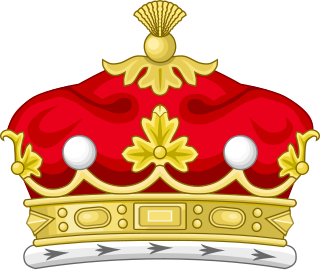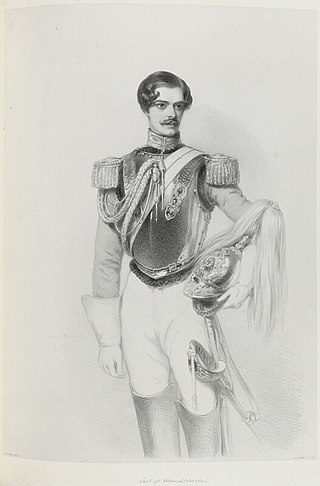Related Research Articles

Field Marshal Richard Molesworth, 3rd Viscount Molesworth, PC (Ire) FRS, styled The Honourable Richard Molesworth from 1716 to 1726, was an Anglo-Irish military officer, politician and nobleman. He served with his regiment at the Battle of Blenheim before being appointed aide-de-camp to the Duke of Marlborough during the War of the Spanish Succession. During the Battle of Ramillies Molesworth offered Marlborough his own horse after Marlborough fell from the saddle. Molesworth then recovered his commander's charger and slipped away: by these actions he saved Marlborough's life. Molesworth went on Lieutenant of the Ordnance in Ireland and was wounded at the Battle of Preston during the Jacobite rising of 1715 before becoming Master-General of the Ordnance in Ireland and then Commander-in-Chief of the Royal Irish Army.

Marquess Conyngham, of the County of Donegal, is a title in the Peerage of Ireland. It was created in 1816 for Henry Conyngham, 1st Earl Conyngham. He was the great-nephew of another Henry Conyngham, 1st Earl Conyngham, a member of a family of Scottish descent which had settled during the Plantation of Ulster in County Donegal in Ireland in the early 17th century. The 'founder' of the dynasty in Ireland was The Very Rev. Dr. Alexander Cunningham, Dean of Raphoe. The earlier Henry was a member of both the Irish House of Commons and the British House of Commons and served as Vice-Admiral of Ulster and as Governor of the counties of Donegal and Londonderry. In 1753 he was raised to the Peerage of Ireland as Baron Conyngham, of Mount Charles in the County of Donegal, and in 1756 he was created Viscount Conyngham, in Ireland, also in the Peerage of Ireland. In 1781 he was made Baron Conyngham, of Mount Charles in the County of Donegal, with remainder to his nephew Francis Burton, and Earl Conyngham, of Mount Charles in the County of Donegal, which like the creations of 1753 and 1756 was created with normal remainder to the heirs male of his body. The latter titles were also in the Peerage of Ireland. Lord Conyngham was childless and on his death in 1781 the barony of 1753, the viscountcy and earldom became extinct while he was succeeded in the barony of 1781 according to the special remainder by his aforementioned nephew Francis. He was the eldest son of Mary, sister of the first Earl Conyngham, by her husband Francis Burton. The new 2nd Baron Conyngham, who had earlier represented Killybegs and County Clare in the Irish House of Commons, assumed by Royal licence the surname and arms of Conyngham on succeeding to the titles.
Henry Burton Conyngham, 1st Marquess Conyngham,, known as The Lord Conyngham between 1787 and 1789, as The Viscount Conyngham between 1789 and 1797 and as The Earl Conyngham between 1797 and 1815, was an Anglo-Irish courtier and politician of the Regency period. He served as Lord Steward between 1821 and 1830.

Francis Nathaniel Conyngham, 2nd Marquess Conyngham, KP, GCH, PC, styled Lord Francis Conyngham between 1816 and 1824 and Earl of Mount Charles between 1824 and 1832, was an Anglo-Irish soldier, courtier, politician and absentee landlord.

James Hamilton, 6th Earl of Abercorn, PC (Ire), was a Scottish and Irish peer and politician. Appointed a groom of the bedchamber to Charles II after the his father's death in battle, he took the Williamite side at the Glorious Revolution and in March 1689 supplied Derry with stores that enabled the town to sustain the Siege of Derry until it was relieved in August. Shortly after inheriting a Scottish and Irish peerage from a second cousin, he was created a viscount in Ireland for his services to the Williamite cause.
Thomas Willoughby, 1st Baron Middleton, was a Tory politician who sat in the English and British House of Commons between 1698 and 1711 when he was raised to the peerage as Baron Middleton as one of Harley's Dozen.
Lieutenant-General William Kerr, 2nd Marquess of Lothian, was a Scottish peer who held a number of minor military and political offices. He was known by the courtesy title of Lord Newbattle until 1692, when he succeeded as Lord Jedburgh, then as Marquess of Lothian when his father died in 1703.
Francis Conyngham, 2nd Baron Conyngham was an Irish peer and politician.

Gustavus Hamilton, 1st Viscount BoynePC (Ire) (1642–1723) was an Irish soldier and politician. In his youth, he fought in his cousin Sir George Hamilton's regiment for the French in the Franco-Dutch War. About 1678 he obtained a commission in the Irish Army. King James II appointed him to his Irish Privy Council in 1685.
The Right Honourable Frederick Hamilton was an Irish politician who represented County Donegal in three Irish parliaments. He was also heir apparent to his father, Gustavus Hamilton, 1st Viscount Boyne. He predeceased him but his son succeeded as the 3rd viscount.

General Sir Charles Wills was a professional soldier from Cornwall, who was Lieutenant-General of the Ordnance and Member of Parliament for Totnes from 1718 to 1741.

Lieutenant-General George Carpenter, 1st Baron Carpenter of Killaghy, 10 February 1657 to 10 February 1731, was a member of the landed gentry from Herefordshire and career soldier in the British Army. He served as Commander-in-Chief, Scotland from 1716 to 1724 and as a Whig MP from 1715 to 1727.
Sir Thomas Smyth, 2nd Baronet was a soldier of the British Army.

The Board of Ordnance in the Kingdom of Ireland (1542–1800) performed the equivalent duties of the British Board of Ordnance: supplying arms and munitions, overseeing the Royal Irish Artillery and the Irish Engineers, and maintaining the fortifications in the island.
Stephen Cornwallis was a career British Army officer and politician who sat in the House of Commons from 1727 to 1743. He reached the rank of Major-General in the Army.
General Gervais Parker was a British Army officer. For the final decade of his life, he served as Commander-in-Chief of the Royal Irish Army during the reign of George II.

Brigadier-General Thomas Paget was a British Army officer and politician who sat in the House of Commons from 1722 to 1727. He was the ancestor of the Paget family, Marquesses of Anglesey.
Lieutenant-General Thomas Meredyth or Meredith, of Chelsea, Middlesex, was an Irish officer of the British Army and a politician who sat in the Parliament of Ireland from 1703 to 1719 and as a Whig in the British House of Commons from 1709 to 1710..
Sir Charles Hotham, 4th Baronet, of Scorborough and later of Beverley and South Dalton, was a British Army officer and Whig politician who sat in the English House of Commons and British House of Commons from 1695 to 1723.
Lord Mark Kerr was a Scottish-born professional soldier, who served in the War of the Spanish Succession and the War of the Quadruple Alliance. He reached the rank of General in the British Army, and held a number of important administration posts, including Governor of Edinburgh Castle.
References
- Cokayne, George Edward (1902). Complete Baronetage. Vol. 2 (1st ed.). Exeter: William Pollard & Co. – 1625 to 1649
- Dalton, Charles (1896). English Army Lists and Commission Registers, 1661 – 1714. Vol. 3. London: Eyre & Spottiswoode. – 1689 to 1694
- Kelly, James (2004). "Conyngham, William Burton (1733–1796)" . In Matthew, Colin; Harrison, Brian (eds.). Oxford Dictionary of National Biography . Vol. 13. New York: Oxford University Press. pp. 80–81. ISBN 0-19-8613636.